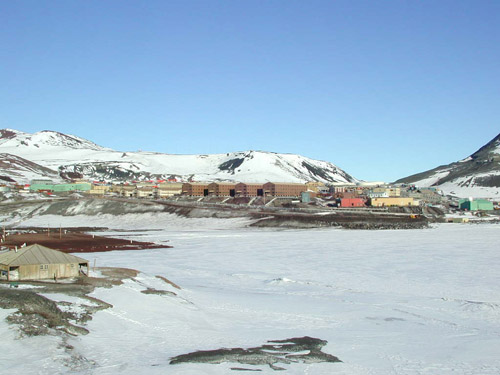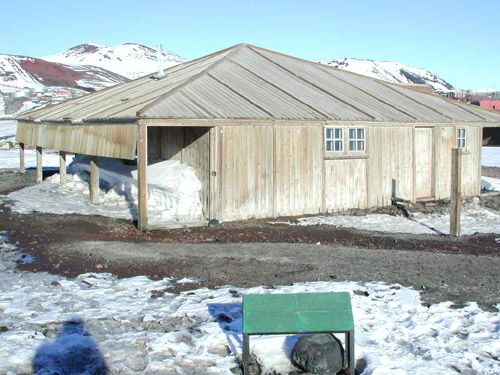
Wednesday, December 13, 2000

Our plane landed at McMurdo base camp around 4:30 PM. McMurdo, as shown above, looks like a modern mining town set in a majestic white wilderness. As it is early in the season, we landed on the ice near the base. Looking around, I saw the majestic white hills and a deep blue sky. As I stepped off the bus, I felt the warm Antarctic sun. The wind was still and temperature around 30 F. It was warm enough to wear a fleece jacket. A bus picked us up and drove us on the ice toward land. As we drove, we saw a seal moving on the ice and several penguins. The penguins looked and moved just as you see in movies.
Several representatives greeted us, gave a safety briefing, explained the rules, and described the opportunities at the camp. My room was in the main facility. It was a typical dorm room except for the fact it had no windows. In summer, the sun is too bright to sleep and in winter, windows are superfluous. The sky was bright blue and sun blazing. People often describe the San Francisco Bay area as a place without seasons. In Antarctica, there is no time. I walked around until late evening. One place that I visited was Scott'without a jacket. At about 8:00 AM, we took a bus to another landing strip. Our plane was fueling, so we had to wait another hour.

At 8:00 PM, we went the bag drop. Our entire checked luggage was weighed and prepared for loading. Then we had our carryon luggage and ourselves weighed for our morning flight to the pole. The only transportation to the pole is via air. After knowing how much we weigh, the flight crew can calculate how much additional cargo to carry. Power is generated at the pole from the excess fuel brought in the plane. It is very important to make the trips to Pole as efficient as possible.
Today, I awoke at 6:00 AM to prepare for my flight. I had breakfast at the cafeteria. I then suited up, with my warm clothing and walked to the departure area. When we arrived, we were told that the flight was delayed. So a group of us took a walk again to Scott's Hut. The sun was as bright as the day before. I walked without a jacket. At about 8:00 AM, we took a bus to another landing strip. Our plane was fueling, so we had to wait another hour.
I walked around the area and viewed the spectacular Mt. Erebus. A small volcanic plume drifts from its top. The airstrip is set of portable buildings aligned neatly in rows surrounded by white mountains and hills.
After the fuel was loaded, we boarded our plane. This time, the passenger space was lightly loaded. There was more legroom than in a first class commercial flight. We put on our earplugs, read the instructions for the emergency oxygen masks, and then fastened our seat belts. Just as the plane started to taxi, we heard an announcement. There was a mechanical problem. We waited for perhaps 20 minutes. After a mechanic examined the hydraulic skis, which are used to take off or land, a flight officer announced that the mechanical problem was serious. We reboarded the bus and headed back to the trailers.
The Day 3 entry described how neutrinos produced muons, which then created light in the ice. Now, how do we detect the light? We use a device called a photomultiplier. This is a very large (8" in diameter) vacuum tube that is coated with a light sensitive area called a photocathode. The photocathode is so sensitive that it can detect one photon (an individual light particle). The phototube through its base converts the light to an electrical signal that we can measure.
Right now as I write this, I am sitting in an empty cafeteria waiting to see whether the plane will be fixed or whether there will be another flight today.
Several hours later, we heard the good news. While the original plane could not be fixed, all of our gear was transferred to another identical plane. We embarked on the plane. Still as spacious as ever. Dressed up full winter gear, we found our seats, put on our earplugs and took off to the pole. I looked out and saw marvelous mountains in a sea of white. Looking down, I realized that probably no human had ever climbed them. After passing through bright blue sky and majestic peaks, we entered a more hazy area with long featureless plateaus. Just as the plane neared the time to make our decent, we heard an ominous message. The weather in the pole was too bad. We would not attempt a landing. Sadly, the pilot announced that we were turning back. Back to McMurdo we will go. We will travel to the pole another day.
Howard Matis